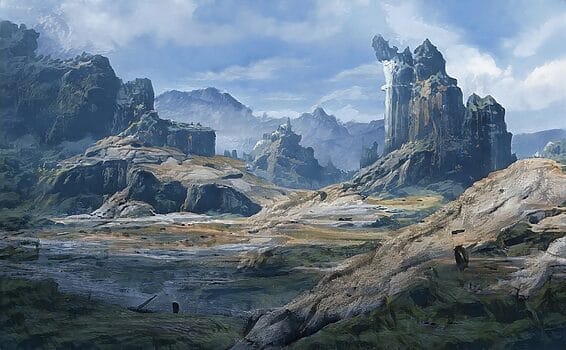Vaesen is an RPG of Gothic Nordic horror set in the Mythic North. The Lost Mountain Saga takes that RPG and dives deep into sacred rituals, Viking heritage, questionable political movements, fictional unexplored riches real to that world, and of course terrifying creatures that haunt the wilds of nineteenth-century Scandinavia. A GM can take these resources and create an entire world of horror and myth guided by real-world history and quite a bit of imagination.

My thanks to Free League for sending me a copy of The Lost Mountain Saga to assist in my continuing coverage of their RPGs. Previous articles have covered The One Ring extensively and other Free League RPGs like the Forbidden Lands.
Mood and Themes
Everything good in Vaesen is doubled down on and expanded in The Lost Mountain Saga. A GM wanting to build a world on the themes of mysterious creatures, dark and dangerous nature, and the changing face of Scandinavian culture will find all those ideas emphasized. In addition, The Lost Mountain Saga dives deep into Viking heritage, political movements, and even a bit of humor mixed in with the horror.
To invoke the mood of intertwined Mysteries, a GM should take the time to link key NPCs to the PCs’ backstories. Franzibald Hansen in particular, has concerns about the Svea Mining Corp mining near the village of Abisko. He is isolated, and hostility toward anyone opposing the mine is rising. If Franzibald is a colleague of a PC, that PC will be very likely to want to help him.
Lisa Johansson is another NPC who may be a friend or acquaintance of a PC, especially one with high Empathy. Lisa has wandered for years and now works as a waitress in the town of Falun. But she has been restless for years and these feelings are going to grow into something much bigger as the Mysteries unfold.
Support for Building the GM’s Setting
A variety of useful maps fills the adventures. Settlements from villages to cities, mines, churches and temples, and islands provide detailed location information and a visual aid to GMs to assist in running Mysteries. A variety of NPCs are included: priests, miners, townsfolk, thugs, mental patients, a sea captain, soldier, and more.
The adventures are packed with vaesen, many pulled from the main rulebook. These vaesen have their own motivations, and many have some rule modifications to match what makes them unique.
Many investigations to uncover clues, discussions with NPCs, unraveling ancient mysteries, dealing with human opponents with conflicting agendas, and facing off against vaesen will make sure the PCs have their hands full. A GM running some or all of these adventures, or just pulling out needed idea and rules, will be fully supported in creating a unique world of Nordic horror.
The Lost Mountain Saga offers other extras a GM can pull out and use. Rituals like a coffee break with a sweet but that shouldn’t be missed under any circumstance add color to local villages. A Viking stone formation holds rune stones pointing the way to an old battleground haunted by Viking ghost warriors. There are also four pages of handouts for the PCs. Finally, power stones with magical power factor in to the ongoing mysteries. In addition to magical properties, the stones have possible military applications as well. The two different properties of the stones ties directly into the final Mystery (more below).
The Mysteries
In Duty and Despair, the town of Falun is haunted both by a vaesen and a human monster. Franzibald kicks off this adventure and can meet the PCs wherever they are. A campaign could start with the PCs investigating their headquarters of Castle Gyllencreutz for the first time and then be followed up with this adventure.
The Beginning of the Fall follows up right after the first adventure. The PCs face off against the powerful Svea Mining Corp if they want to help their friend, Franzibald. Vocal critics of the mining corporation have gone missing or have wound up dead. Franzibald is one such critic and he is certainly at risk. The PCs are very likely going to investigate on his behalf.
Where the Sun Dies finds the PCs on a remote island facing a frozen vaesen menace and villagers willing to kill to hide their secrets. A quintessential vaesen Mystery.
Another classic spin on the vaesen Mystery is The Prince and the Witch. The PCs face off against another vaesen as well as the leader of a secret order with her own secrets she’s trying to keep.
The Lost Mountain Saga is the final mystery with global repercussions. The main villain of the campaign, Sigrid, and her followers, are a final threat as are the vaesen who are seeing their ancient world collapsing around them.
Sigrid and her ally Karl are also in conflict, using each other for their own aims. Sigrid wants powerful magic from the power stones and Karl wants political power and using the stones they’ve found as weapons. These two opposing goals clash in the final Mystery.
Finally, Lisa’s wandering is explained and comes full circle. Sigrid doesn’t even know who she is at the start of the adventure, but both of them will come into conflict.
In the end, a powerful vaesen is summoned to bring their reign back to Scandinavia. The PCs can try to stop the ritual Sigrid is performing to summon the creature. But a more immediate threat endangers everyone in the conflict and the PCs will likely flee. In the end, those of them who survive, will be some of the few people who know the real truth of the lost mountain saga.
Should You Get Vaesen and The Lost Mountain Saga
Yes.
Oh, you want a bit more?
The Lost Mountain Saga is not something I can run right now. But the book is wonderfully made and full of great ideas, amazing art, useful maps, and an entertaining story of what could be around a game table. It inspires even if you can’t run it immediately. Vaesen is put together in the same way. Well worth having to enjoy reading for inspiration and as a visual feast for the eyes. And hopefully, one day, to be run with a group of eager players.
Picture credit: Pixabay


